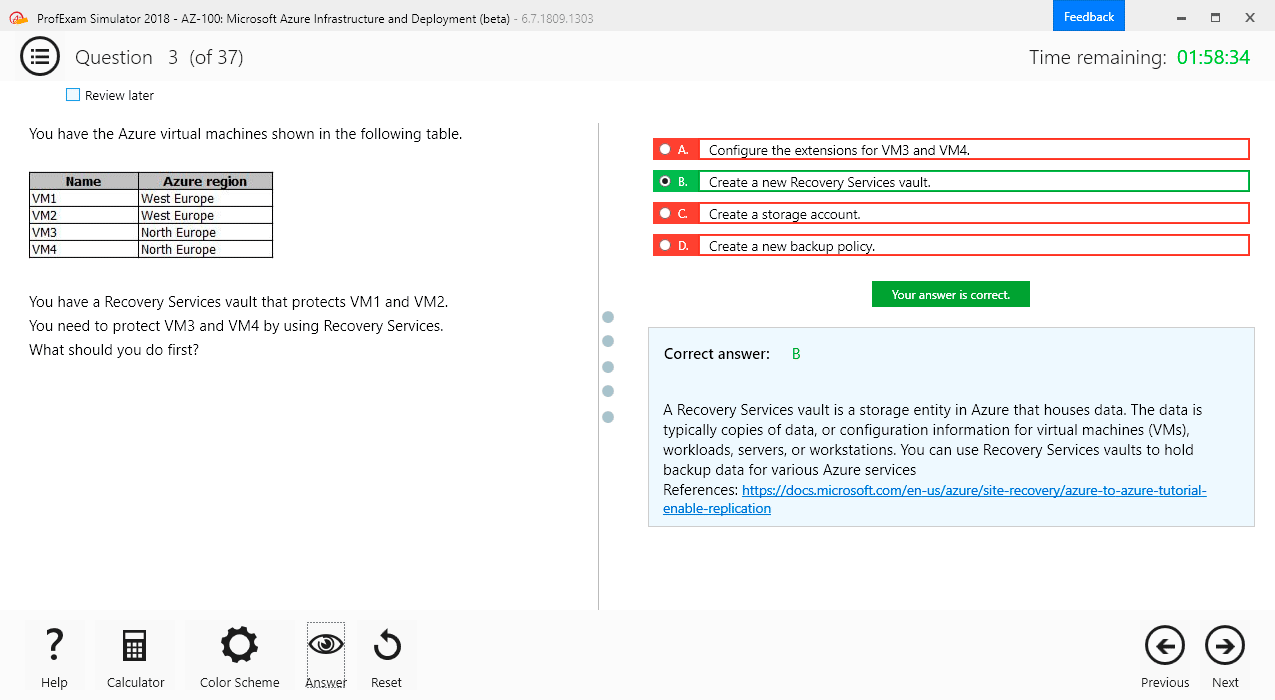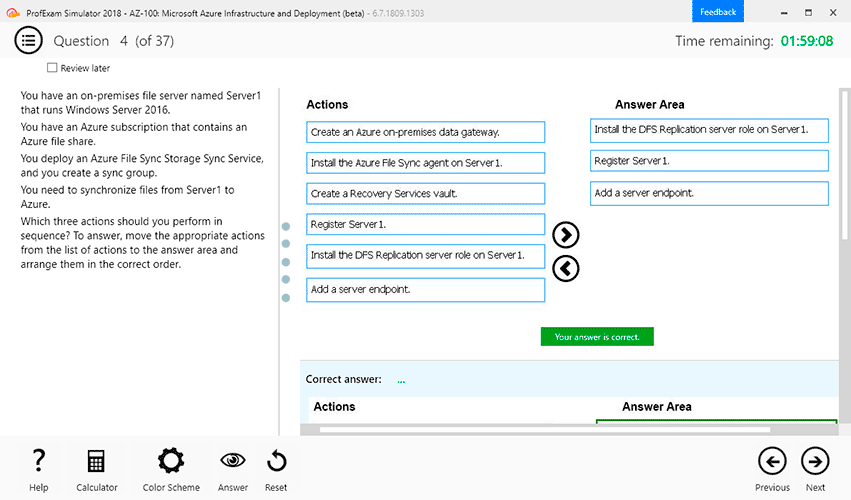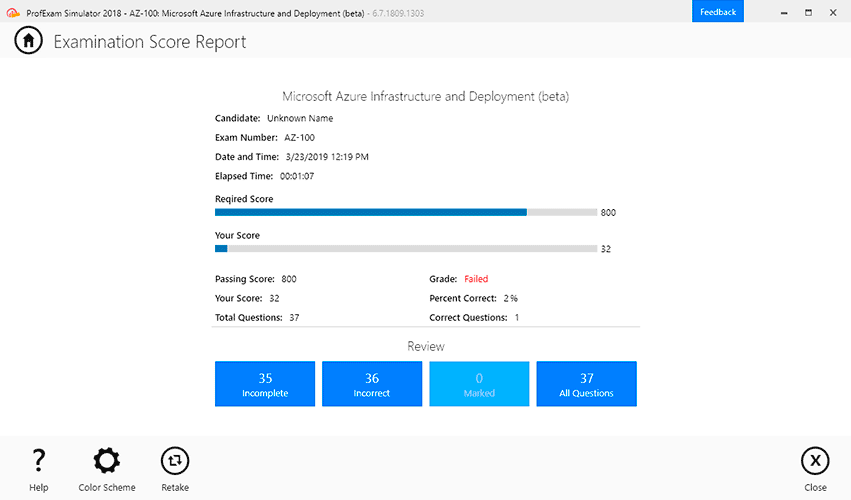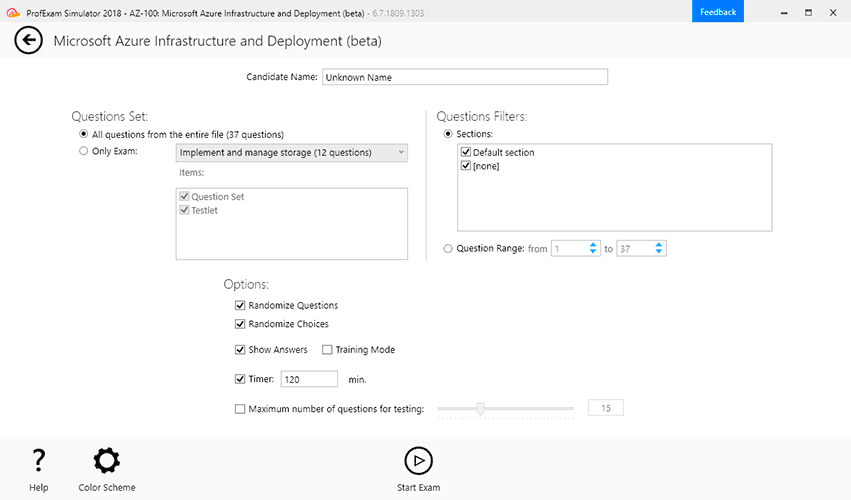File Info
| Exam | Microsoft Power Platform Developer |
| Number | PL-400 |
| File Name | Microsoft.PL-400.VCEplus.2020-12-15.34q.vcex |
| Size | 3 MB |
| Posted | Dec 15, 2020 |
| Download | Microsoft.PL-400.VCEplus.2020-12-15.34q.vcex |
How to open VCEX & EXAM Files?
Files with VCEX & EXAM extensions can be opened by ProfExam Simulator.
Coupon: MASTEREXAM
With discount: 20%






Demo Questions
Question 1
You need to add the script for the registration form event handling.
Which code segment should you use?
- formContext.data.entity.addOnSave(myFunction)
- formContext.data.addOnLoad(myFunction)
- formContext.data.removeOnLoad(myFunction)
- addOnPreProcessStatusChange
- formContext.data.isValid()
Correct answer: B
Explanation:
Scenario: Information about upcoming tournaments must be pre-located into the registration form when the registration form loads. addOnLoad adds event handlers to the Subgrid OnLoad event event.Reference: https://docs.microsoft.com/en-us/powerapps/developer/model-driven-apps/clientapi/reference/grids/gridcontrol/addonload Scenario: Information about upcoming tournaments must be pre-located into the registration form when the registration form loads. addOnLoad adds event handlers to the Subgrid OnLoad event event.
Reference: https://docs.microsoft.com/en-us/powerapps/developer/model-driven-apps/clientapi/reference/grids/gridcontrol/addonload
Question 2
A company is creating a Power Apps portal to collaborate with vendors.
You need to implement custom functionality in the portal by using JavaScript code.
Which two portal entities can you use? Each correct answer presents a complete solution.
NOTE: Each correct selection is worth one point.
- Web pages
- Web resources
- Webforms
- Entity lists
Correct answer: CD
Explanation:
C: The Web Form Step record contains a field named Custom JavaScript that can be used to store JavaScript code to allow you to extend or modify the form's visual display or function.D: You can add custom Javascripts to Entity lists.Reference: https://docs.microsoft.com/en-us/powerapps/maker/portals/configure/add-custom-javascript https://docs.microsoft.com/en-us/powerapps/maker/portals/configure/entity-lists#add-custom-javascript C: The Web Form Step record contains a field named Custom JavaScript that can be used to store JavaScript code to allow you to extend or modify the form's visual display or function.
D: You can add custom Javascripts to Entity lists.
Reference: https://docs.microsoft.com/en-us/powerapps/maker/portals/configure/add-custom-javascript https://docs.microsoft.com/en-us/powerapps/maker/portals/configure/entity-lists#add-custom-javascript
Question 3
- Windows Communication Foundation (WCF)
- Cross-Origin Resource Sharing (CORS)
- Microsoft Authentication Library (MSAL)
- Kerberos authentication
- Active Directory Authentication Library (ADAL)
Correct answer: D
Explanation:
OAuth requires an identity provider for authentication. For Dataverse the identity provider is Azure Active Directory (AAD). To authenticate with AAD using a Microsoft work or school account, use the Azure Active Directory Authentication Libraries (ADAL).Reference:https://docs.microsoft.com/en-us/powerapps/developer/common-data-service/authenticate-oauth OAuth requires an identity provider for authentication. For Dataverse the identity provider is Azure Active Directory (AAD). To authenticate with AAD using a Microsoft work or school account, use the Azure Active Directory Authentication Libraries (ADAL).
Reference:
https://docs.microsoft.com/en-us/powerapps/developer/common-data-service/authenticate-oauth
Question 4
A company needs to illustrate the relationships of the entities in Dynamics 365 Sales.
You need to select the appropriate tool to show this graphic.
Which tool should you select?
- Metadata diagram
- Sales Insights
- Power Automate
- Security model
Correct answer: A
Explanation:
Visual representation of metadata can be useful, especially when you are trying to describe the relationship between entities in the system. You can use the Metadata Diagram sample code provided for Dynamics 365 Customer Engagement (on-premises) to generate the entity relationship diagrams.You can create a diagram that shows a relationship for just one entity, or a complex diagram that includes dozens of related entities, including custom and system entities.Reference: https://docs.microsoft.com/en-us/dynamics365/customerengagement/on-premises/developer/use-metadata-generate-entity-diagrams Visual representation of metadata can be useful, especially when you are trying to describe the relationship between entities in the system. You can use the Metadata Diagram sample code provided for Dynamics 365 Customer Engagement (on-premises) to generate the entity relationship diagrams.
You can create a diagram that shows a relationship for just one entity, or a complex diagram that includes dozens of related entities, including custom and system entities.
Reference: https://docs.microsoft.com/en-us/dynamics365/customerengagement/on-premises/developer/use-metadata-generate-entity-diagrams
Question 5


A company uses five different shipping companies to deliver products to customers. Each shipping company has a separate service that quotes delivery fees for destination addresses.
You need to design a custom connector that retrieves the shipping fees from all the shipping companies by using their APIs.
Which three elements should you define for the custom connector? Each correct answer presents part of the solution.
NOTE: Each correct selection is worth one point.
- Authentication model
- Address parameter
- OpenAPI definition
- Fee parameter
- Fee reference
Correct answer: ABC
Explanation:
C: You can create a custom connector using a OpenAPI definition file or a URL to OpenAPI definition.B: On the Security page you get to choose how to authenticate to the API. A: If you were to create a Custom Connector from scratch, then you whould have to study the API you have chosen and type in the URL manually here. Reference: https://carinaclaesson.com/2019/09/06/setting-up-a-custom-connector-from-an-openapi-file-and-utilizing-it-in-powerapps-and-flow/ C: You can create a custom connector using a OpenAPI definition file or a URL to OpenAPI definition.
B: On the Security page you get to choose how to authenticate to the API.

A: If you were to create a Custom Connector from scratch, then you whould have to study the API you have chosen and type in the URL manually here.

Reference: https://carinaclaesson.com/2019/09/06/setting-up-a-custom-connector-from-an-openapi-file-and-utilizing-it-in-powerapps-and-flow/
Question 6
You are creating a Power Apps app that retrieves customer information from Azure Active Directory when you use the app to look up a customer record.
You create an Azure Function by using JSON code to retrieve the customer information.
You need to make the application work.
Which two actions should you perform? Each correct answer presents part of the solution.
NOTE: Each correct selection is worth one point.
- Create a Power Automate flow to import data.
- Create a custom connector that uses the Azure Function API.
- Copy your JSON code to the app.
- Create a custom connector that uses the JSON code.
- Create an API definition for the Azure Function.
Correct answer: BE
Explanation:
E: Before exporting an API, you must describe the API using an OpenAPI definition.B: This OpenAPI definition contains information about what operations are available in an API and how the request and response data for the API should be structured. PowerApps and Microsoft Flow can create custom connectors for any OpenAPI 2.0 definition.Reference: https://github.com/MicrosoftDocs/azure-docs/blob/master/articles/azure-functions/app-service-export-api-to-powerapps-and-flow.md E: Before exporting an API, you must describe the API using an OpenAPI definition.
B: This OpenAPI definition contains information about what operations are available in an API and how the request and response data for the API should be structured. PowerApps and Microsoft Flow can create custom connectors for any OpenAPI 2.0 definition.
Reference: https://github.com/MicrosoftDocs/azure-docs/blob/master/articles/azure-functions/app-service-export-api-to-powerapps-and-flow.md
Question 7
You are creating an integration that uses an Azure function to create records in the Common Data Service when leads are submitted from your company website.
You create and configure a Common Data Service application user.
You do not have administrator access to the Common Data Service environment you are using for access to Azure Active Directory. Company policy dictates that service accounts must be used for integrations, and integrations must not be granted privileges beyond what is needed.
You need to recommend actions that an administrator should perform to configure access for the Azure Function.
Which three actions should you perform? Each correct selection presents part of the solution.
NOTE: Each correct selection is worth one point.
- Create an application registration in Azure Active Directory.
- Assign the system administrator security role to the application user.
- Assign the Power Platform administrator role to the application user in Azure Active Directory.
- Create a new security role with the minimum required permissions and assign to the application user.
- Grant the application delegated permissions to the Dynamics CRM API in Azure Active Directory.
- Deploy Azure B2B guest permissions to the application user.
Correct answer: ADE
Explanation:
Reference: https://docs.microsoft.com/en-us/powerapps/developer/common-data-service/walkthrough-register-app-azure-active-directory Reference: https://docs.microsoft.com/en-us/powerapps/developer/common-data-service/walkthrough-register-app-azure-active-directory
Question 8
You need to identify the execution mode that is being used for the ISV solution reported by User5.
Which type of execution mode is in use?
- asynchronous
- atomicity
- transfer
- synchronous
Correct answer: D
Explanation:
User5 receives the error message: 'Endpoint unavailable' during a test of the technician dispatch ISV solution.When you choose to use a synchronous execution mode any failure will be reported back to the user of the application with an Endpoint unavailable error dialog informing the user that the webhook service endpoint may be configured incorrectly or is not available.Reference: https://docs.microsoft.com/en-us/powerapps/developer/common-data-service/use-webhooks Question Set 2 User5 receives the error message: 'Endpoint unavailable' during a test of the technician dispatch ISV solution.
When you choose to use a synchronous execution mode any failure will be reported back to the user of the application with an Endpoint unavailable error dialog informing the user that the webhook service endpoint may be configured incorrectly or is not available.
Reference: https://docs.microsoft.com/en-us/powerapps/developer/common-data-service/use-webhooks Question Set 2
Question 9
Note: This question is part of a series of questions that present the same scenario. Each question in the series contains a unique solution that might meet the stated goals. Some question sets might have more than once correct solution, while others might not have a correct solution.
After you answer a question in this section, you will NOT be able to return to it. As a result, these questions will not appear in the review screen.
You are designing a one-way integration from the Common Data Service to another system.
You must use an Azure Function to update the other system. The integration must send only newly created records to the other system. The solution must support scenarios where a component of the integration is unavailable for more than a few seconds to avoid data loss.
You need to design the integration solution.
Solution: Register a webhook in the Common Data Service that connects to the Azure Function. Register a step on the webhook which runs synchronously on the record's Create message and in the post-operation stage.
Does the solution meet the goal?
- Yes
- No
Correct answer: B
Explanation:
Instead use asynchronous communication. Instead use asynchronous communication.
Question 10
Note: This question is part of a series of questions that present the same scenario. Each question in the series contains a unique solution that might meet the stated goals. Some question sets might have more than once correct solution, while others might not have a correct solution.
After you answer a question in this section, you will NOT be able to return to it. As a result, these questions will not appear in the review screen.
You are designing a one-way integration from the Common Data Service to another system.
You must use an Azure Function to update the other system. The integration must send only newly created records to the other system. The solution must support scenarios where a component of the integration is unavailable for more than a few seconds to avoid data loss.
You need to design the integration solution.
Solution: Register a service endpoint in the Common Data Service that connects to an Azure Service Bus queue.
Register a step at the endpoint which runs asynchronously on the record's Create message and in the port-operation stage.
Configure the Azure Function to process records as they are added to the queue.
Does the solution meet the goal?
- Yes
- No
Correct answer: A
Explanation:
Microsoft Dataverse supports integration with Azure.For the Dataverse and Azure connection to work, there must be at least one solution in an Azure Service Bus solution account, where the solution contains one or more service endpoints. For a queue endpoint contract, a listener doesn't have to be actively listening.Reference: https://docs.microsoft.com/en-us/powerapps/developer/common-data-service/azure-integration Microsoft Dataverse supports integration with Azure.
For the Dataverse and Azure connection to work, there must be at least one solution in an Azure Service Bus solution account, where the solution contains one or more service endpoints. For a queue endpoint contract, a listener doesn't have to be actively listening.
Reference: https://docs.microsoft.com/en-us/powerapps/developer/common-data-service/azure-integration

